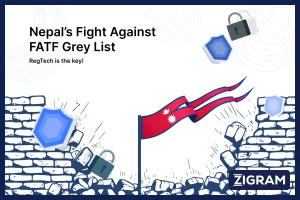On October 10, 2024, TD Bank faced what can be described as one of the most significant financial penalties in history—$3 billion—after pleading guilty to charges of money laundering and violations of the Bank Secrecy Act (BSA). This case, involving more than $670 million funneled through criminal networks for activities like drug trafficking and terrorist financing, brings to light the urgent need for financial institutions to step up their Anti-Money Laundering (AML) game.
As regulatory requirements tighten, relying on conventional methods is no longer enough. It’s time to embrace modern technologies like artificial intelligence (AI) and machine learning (ML) to effectively combat financial crime. In this article, we’ll take a closer look at the key lessons from the TD Bank case and explore how AML solutions can help address these risks.

TD Bank's $3 Billion Fine: A Loud Wake-Up Call For The Financial Industry
The $3 billion fine imposed on TD Bank is a strong message to the entire financial community about the severe consequences of non-compliance with AML regulations. From 2014 to 2023, TD Bank’s outdated AML system allowed over $670 million in illicit funds to slip through unnoticed, fueling criminal activities across the globe. It’s clear that AML compliance is not just about avoiding fines—it’s about safeguarding the financial system and protecting the institution’s reputation.
Key Failings - TD Bank
A) Insufficient or Lax Transaction Monitoring
TD Bank’s systems failed to properly monitor over 80% of domestic transactions, including high-risk activities like ACH, wire transfers, and peer-to-peer (P2P) payments. These unchecked transactions allowed vast sums of illegal money to flow through the bank undetected.
What Happened: With no real-time monitoring in place, large transfers between suspicious entities, particularly those tied to drug trafficking and terrorist groups, were allowed to go through. This created a breeding ground for criminal networks to launder money without raising alarms.
What Could Have Helped: Real-time transaction monitoring could have flagged suspicious patterns early, allowing compliance teams to investigate and take action swiftly.
B) Failure to File Suspicious Activity Reports
The bank neglected to file SARs for over $1.5 billion in suspicious transactions. This is a key obligation for any financial institution, as SARs are crucial for alerting regulators to potentially illegal activities.
What Happened: Despite clear indicators of suspicious behavior, TD Bank allowed backlogs to build, and many suspicious transactions went unreported, giving criminals a free pass to continue their operations.
What Could Have Helped: Automating SAR processes through AI-driven tools would have ensured timely filings, minimizing human error and reducing the risk of transactions going unnoticed.
C) Internal Corruption
A shocking revelation from the case was the discovery that an employee of TD Bank was actively laundering narcotics proceeds in exchange for bribes. This internal threat compounded the bank's external AML weaknesses, highlighting the need for stronger internal controls.
What Happened: The employee used insider knowledge to manipulate the system and cover up illicit activity, allowing dirty money to flow through the bank without detection.
What Could Have Helped: Enhanced internal monitoring systems could have flagged unusual employee activity, preventing this kind of internal fraud from going undetected for years.
The Consequences: More Than Just Financial Damage
The $3 billion fine is only one part of the punishment. TD Bank now faces long-lasting reputational damage, heightened regulatory scrutiny, and an independent monitorship imposed by the Financial Crimes Enforcement Network (FinCEN) and the Department of Justice (DOJ). The message is clear: financial institutions cannot afford to let their guard down when it comes to AML compliance.
Regulatory Scrutiny
TD Bank will now be under close watch for at least four years, with regulators requiring regular updates and proof that the bank is improving its AML systems. This kind of scrutiny can be invasive and costly. Every financial institution must take a proactive approach to AML compliance. It’s no longer enough to have basic systems in place—institutions need advanced technology and processes to meet rising regulatory expectations.
Reputational Damage
In an industry where trust is everything, the hit to TD Bank’s reputation will be significant. Customers, partners, and investors may hesitate to engage with a bank involved in such high-profile regulatory breaches. Maintaining a reputation for compliance and trustworthiness is critical. Financial institutions must prioritize AML efforts not just to avoid fines but to protect their brand and customer relationships.
Missed Red Flags: Why Advanced Monitoring Tools Are Essential
One of the most alarming revelations from the TD Bank case was the numerous red flags that were overlooked due to the bank’s outdated monitoring systems. High-volume transactions between risky entities and large sums transferred to countries with known links to terrorism were among many opportunities to stop illegal activity—yet none were identified.
1. Detecting Anomalies in Real Time
Modern AML systems can process vast amounts of transactional data and identify unusual patterns that indicate suspicious activity. This helps reduce false positives and enhances detection accuracy. Rather than depending solely on preset thresholds or manual intervention, advanced monitoring tools learn from historical data to identify trends that conventional systems might miss. For example, subtle changes in transaction behavior that indicate money laundering can be flagged more efficiently.
2. Tracking Complex Transactions
Criminal networks often use sophisticated strategies to move funds across borders. Modern tools can trace the flow of money between accounts, making it easier for financial institutions to identify suspicious activities. By mapping out the movement of funds, institutions can uncover links to illicit networks, even across different jurisdictions, something that manual processes often miss.
Prevention Is Better Than Cure: Strengthening Internal Controls
TD Bank’s case also serves as a reminder of the risks financial institutions face when internal controls are insufficient. Prevention is always the best approach, and improving internal systems is key to preventing financial crimes before they take root.
1. Risk-Based Customer Profiling
Financial institutions must assign risk scores to customers based on transaction size, frequency, geographic location, and other patterns. This ensures that resources are focused on the highest-risk clients. By analyzing customer behavior and past transaction data, institutions can flag unusual activities and conduct deeper investigations when necessary. ZIGRAM’s Solution: Our Entity Hero solution helps create dynamic risk profiles, allowing institutions to focus on individuals and transactions that pose the greatest risk.
2. Enhanced Due Diligence (EDD)
Periodic account reviews and continuous risk assessment are essential to catch issues before they escalate. Automating these processes ensures that even minor red flags are addressed promptly. How It Works: Automated due diligence reviews help institutions identify early warning signs and trigger investigations before problems grow larger.
Key Takeaways For Financial Institutions
The experience of TD Bank sends a clear message: the cost of inaction or complacency in AML compliance is too high. As regulations grow more stringent and penalties increase, financial institutions must now act to upgrade their compliance systems and ensure they are resilient enough to handle modern financial crime.
1. Invest in Technology : Advanced AML solutions are no longer optional—they are a necessity for staying compliant and preventing financial crimes. By integrating better technology into their AML frameworks, financial institutions can avoid fines, protect themselves from reputational damage, and stay ahead of evolving threats.
2. Foster a Culture of Compliance : Compliance should be ingrained at every level of the organization, from top management down to the front lines. A strong culture of compliance reduces internal risks and strengthens the institution’s ability to meet regulatory requirements.
3. Prepare for Increased Scrutiny : As regulatory bodies increase their oversight; financial institutions must ensure their AML systems are flexible and robust enough to handle evolving risks. Institutions that continually update and improve their AML systems will be better positioned to avoid penalties and remain compliant in the face of heightened scrutiny.
Conclusion
The TD Bank case should serve as a wake-up call to the financial sector. Strengthening AML systems is no longer optional—it’s a requirement. With ZIGRAM’s advanced solutions, financial institutions can build resilient frameworks to detect, prevent, and mitigate risks associated with financial crimes.
Now is the time to strengthen your defenses against financial crime. Partner with ZIGRAM to implement advanced AML solutions and safeguard your institution. Schedule a demo here.
- #TDBank
- #MoneyLaundering
- #AML
- #FinancialCrime
- #FinancialCompliance
- #BankSecrecyAct
- #RegulatoryCompliance
- #UKRegulations
- #FinancialInstitutions
- #ReputationRisk
- #TransactionMonitoring
- #RiskAssessment
- #SARs
- #Fintech
- Compliance
- #TransactComply
- #FinancialRegulations






